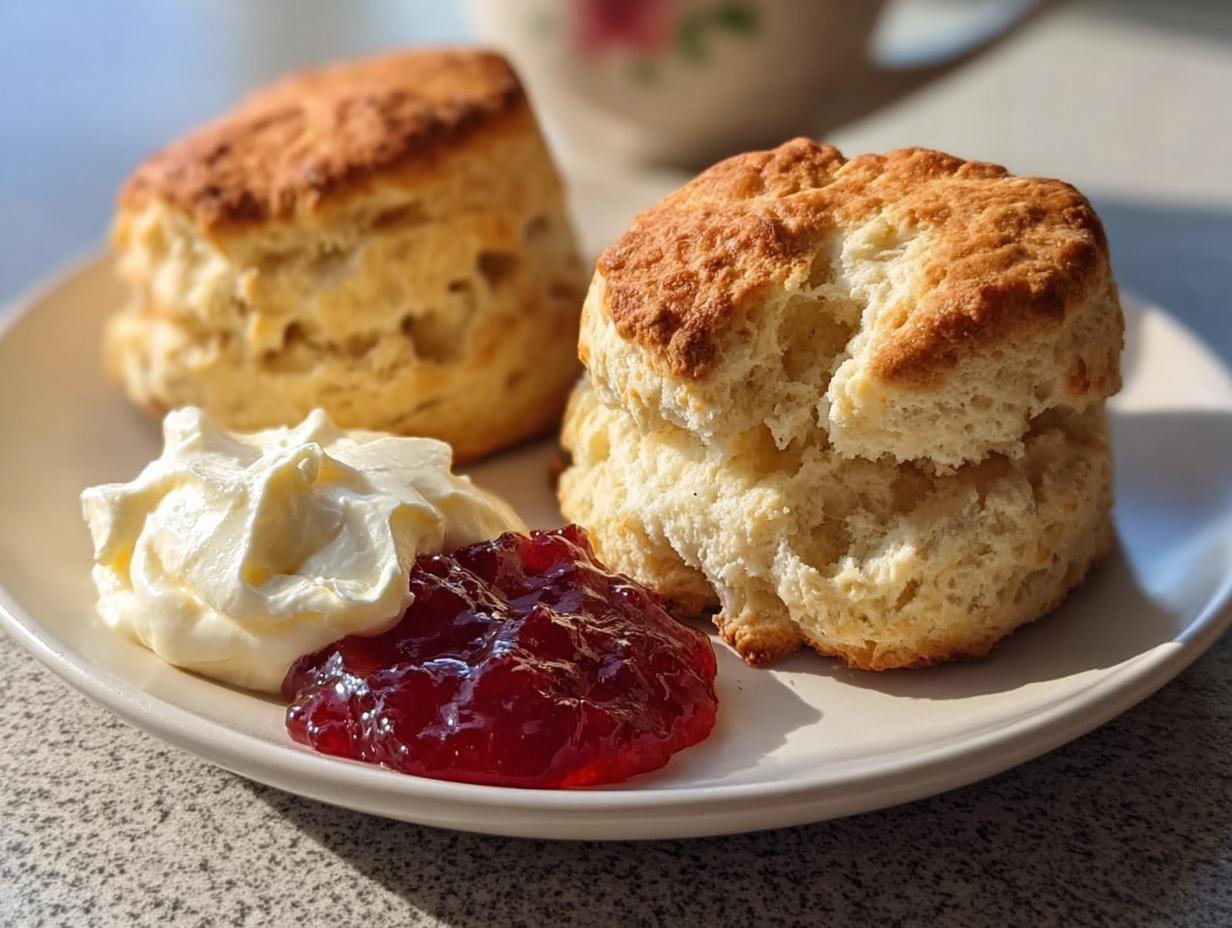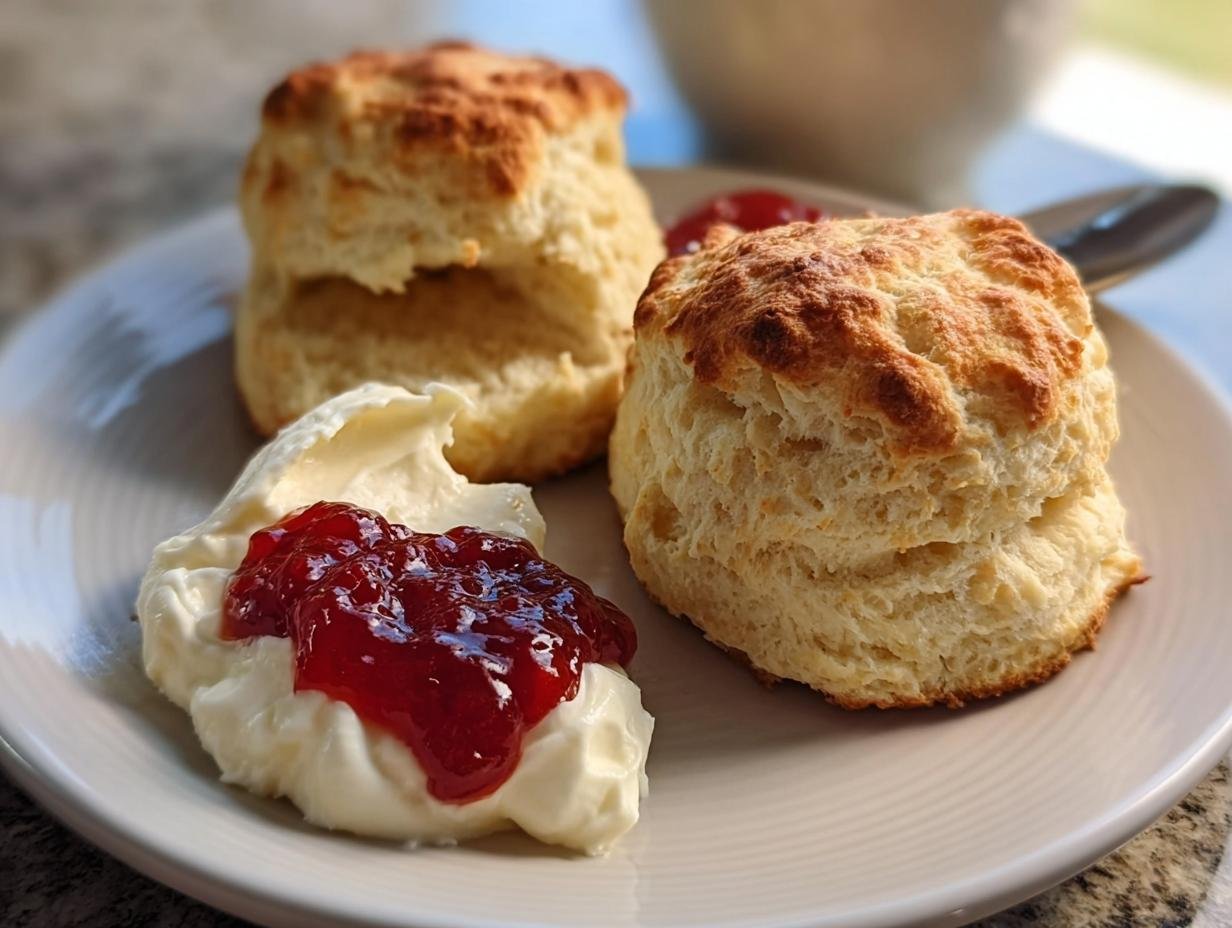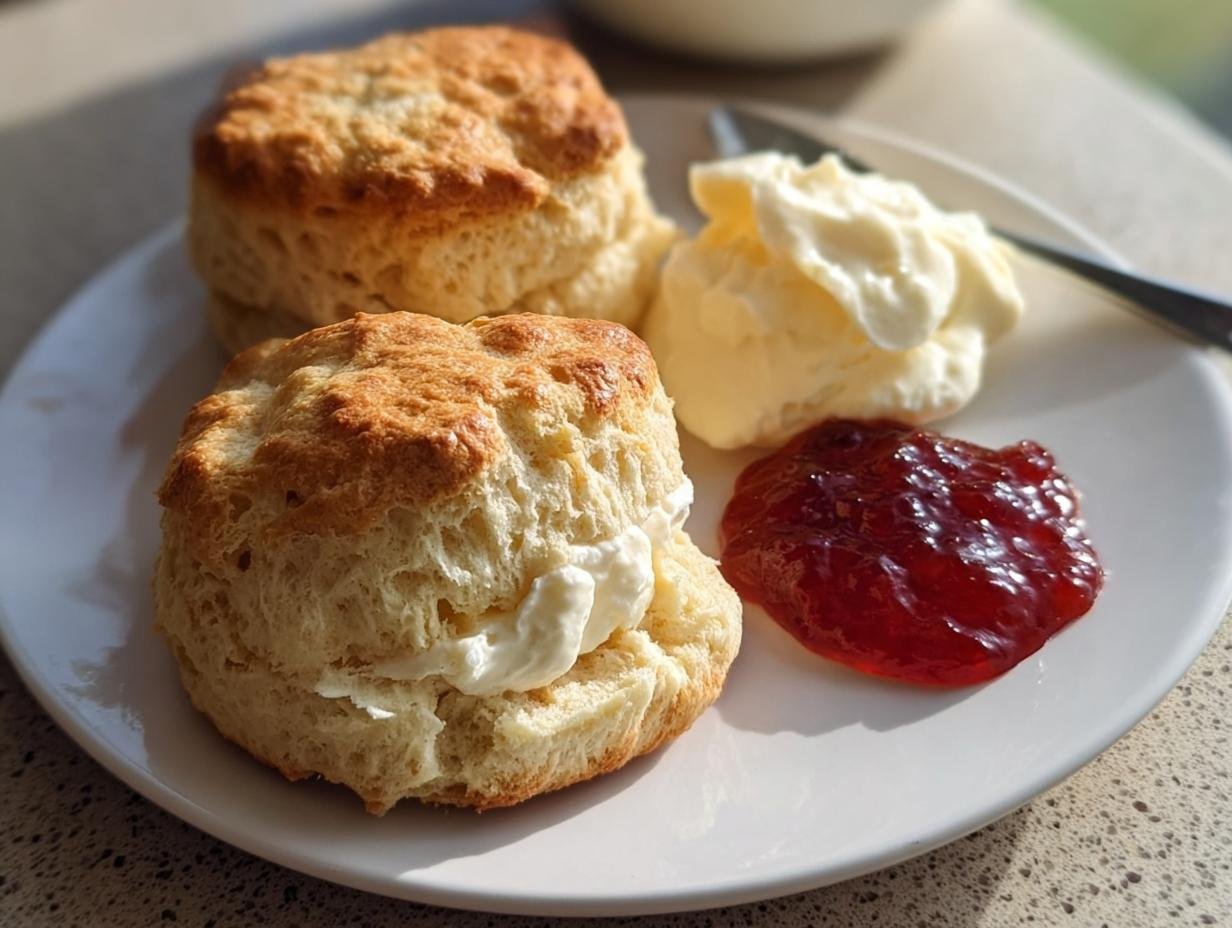British Scones have been a cherished part of my tea-time ritual for as long as I can remember. There’s something incredibly comforting about the smell of them baking, a warm, buttery aroma that fills the kitchen and promises a delightful treat. My grandmother taught me how to make Authentic British Scones, and the memory of her hands dusting flour and shaping the dough is so vivid. They are perfectly tender and crumbly, just begging for a dollop of clotted cream and a spoonful of sweet strawberry jam. If you’ve ever wondered how to make British Scones that taste like they came straight from a traditional English tea room, you’re in the right place. Let’s get cooking!

Why You’ll Love This British Scones Recipe
You’ll adore this British Scones recipe for so many reasons:
- Incredible Taste: Experience that classic, buttery flavor and perfectly tender texture that makes these scones a delight.
- Quick Prep: This is an easy British scones recipe, with minimal fuss and ready for the oven in just 25 minutes.
- Budget-Friendly: Made with simple pantry staples, these scones are an affordable way to enjoy a special treat.
- Family Favorite: Kids and adults alike will love helping to make and devour these delicious homemade goodies.
- Versatile Treat: Perfect for afternoon tea, a quick breakfast, or a comforting snack any time of day.
- Impressive Results: Even if you’re new to baking, this easy British scones recipe guarantees impressive, authentic results.
- Simple Ingredients: You likely have most of the necessary British Scone ingredients already in your kitchen!
British Scone Ingredients
Gathering the right British Scone ingredients is the first step to creating the perfect batch. These simple components come together to make something truly special:
- 2 cups unbleached all-purpose flour: This provides the structure for our scones.
- 2 tablespoons sugar: Just enough sweetness to balance the flavors.
- 4 teaspoons baking powder: The magic ingredient for that signature fluffy lift!
- ½ teaspoon salt: Enhances all the other flavors.
- 3 tablespoons cold unsalted butter: Crucial for creating those tender, flaky layers. Make sure it’s cold!
- ⅔ cup milk: This helps bind the dough and adds moisture.
- 1 egg yolk beaten with 1 tablespoon milk (for glazing): This creates a beautiful golden sheen on top.
- Strawberry jam (to serve): A classic accompaniment for a burst of fruity sweetness.
- Clotted cream (at room temperature, to serve): The essential partner for that authentic cream tea experience.
How to Make British Scones
Making British Scones is a straightforward process that yields incredibly rewarding results. Follow these steps, and you’ll be enjoying warm, fluffy scones in no time. This is how how to bake British Scones like a pro!
- Step 1: Preheat your oven to 425°F (220°C). While the oven heats, lightly grease and flour a baking sheet, or line it with parchment paper. This prevents sticking and ensures a beautiful finish.
- Step 2: In a medium mixing bowl, whisk together the 2 cups unbleached all-purpose flour, 2 tablespoons sugar, 4 teaspoons baking powder, and ½ teaspoon salt. Give it a good stir to ensure everything is evenly distributed – this is key for consistent lift.
- Step 3: Add the 3 tablespoons cold unsalted butter to the dry ingredients. Using your fingertips or a pastry blender, rub the butter into the flour mixture until it resembles coarse breadcrumbs. You want small, pea-sized pieces of butter remaining; these create the flaky layers.
- Step 4: Gradually pour in the ⅔ cup milk, mixing gently with a fork or spatula until a sticky dough just begins to form. Be careful not to overmix at this stage; you’re looking for a shaggy dough that holds together.
- Step 5: Turn the dough out onto a lightly floured surface. Gently knead the dough just a few times – about 5-6 turns – until it comes together. Then, press it down with your hands to about one inch thick. This is where you develop a little structure without toughening the dough.
- Step 6: Using a two-inch round cookie cutter, cut out your scones. Press the cutter straight down without twisting, as twisting can seal the edges and prevent them from rising evenly. Re-gather and press scraps gently to cut more scones.
- Step 7: Place the cut scones onto your prepared baking sheet, spacing them about an inch apart.
- Step 8: In a small bowl, whisk together the 1 egg yolk and 1 tablespoon milk for the glaze. Brush this mixture evenly over the tops of the scones. This step is crucial for that gorgeous golden-brown color when you how to bake British Scones.
- Step 9: Bake for 12–15 minutes, or until the scones are puffed, golden brown on top, and firm to the touch. The aroma filling your kitchen will be absolutely divine!
- Step 10: Once baked, transfer the scones to a wire rack to cool for about 30 minutes before serving them warm. Enjoying them fresh from the oven is truly the best way to experience how to bake British Scones perfectly.

Pro Tips for The Perfect British Scone
Achieving that bakery-quality texture at home is totally doable with a few insider tricks. These tips will help guarantee your British Scones are light, fluffy, and absolutely delicious every single time.
- Keep your butter and milk as cold as possible. Cold ingredients are key to creating those flaky layers.
- Don’t overwork the dough! Gentle handling is crucial for a tender crumb. Over-kneading develops gluten, leading to tough scones.
- Use a sharp cookie cutter and press straight down. Twisting can seal the edges and prevent an even rise, which is vital for classic British scones.
- For an extra fluffy texture, try to get your oven as hot as possible before baking.
What’s the secret to perfect British Scones?
The real secret to the perfect British scone lies in keeping your ingredients cold and your handling of the dough minimal. Cold butter creates steam pockets during baking, giving you that airy, flaky texture everyone loves. For more baking tips, you can check out our baking philosophy.
Can I make Authentic British Scones ahead of time?
Yes, you can prepare your Authentic British Scones dough ahead of time. Form the dough, cut out the scones, and place them on your baking sheet, then cover them tightly with plastic wrap and refrigerate for up to 24 hours before baking.
How do I avoid common mistakes with Traditional British Scone Recipe?
Avoid overmixing the dough, as this makes scones tough. Also, don’t twist the cutter – press straight down to ensure a good rise. Lastly, ensure your baking powder is fresh for that essential lift in your traditional British scone recipe. For more on baking science, you can explore resources on leavening agents.
Best Ways to Serve British Scones
Serving your freshly baked British Scones is almost as fun as making them! The most traditional and beloved way to enjoy them is as part of a classic cream tea, often referred to as cream tea scones. For this, you’ll need a generous dollop of thick clotted cream and a spoonful of sweet strawberry jam. Make sure the cream is at room temperature for easy spreading.
Another delightful option is to serve them warm with a smear of good quality butter and a drizzle of honey or a dollop of lemon curd. These simple additions highlight the delicate flavor of the scone itself. For a slightly more decadent treat, you could even add a sprinkle of powdered sugar on top after glazing. They’re perfect for any afternoon gathering or a cozy breakfast. Learn more about the history of afternoon tea here.

Nutrition Facts for British Scones
When enjoying these delightful British Scones, it’s helpful to know what you’re consuming. Each serving offers a taste of tradition without being overly heavy. These figures are based on the recipe as written, providing a good estimate for your planning.
- Calories: 180
- Fat: 7g
- Saturated Fat: 4g
- Protein: 4g
- Carbohydrates: 26g
- Fiber: 0g
- Sugar: 4g
- Sodium: 160mg
Nutritional values are estimates and may vary based on specific ingredients used. For more information on dietary guidelines, consult official health recommendations.
How to Store and Reheat British Scones
Once your delicious British Scones have cooled completely, proper storage is key to keeping them fresh and enjoyable. For short-term storage, place them in an airtight container or a resealable bag at room temperature. This will help maintain their texture for about 3-4 days. If you find yourself with a surplus or want to prepare ahead for future tea times, freezing is an excellent option for these traditional UK scones. Wrap each cooled scone individually in plastic wrap, then place them in a freezer-safe bag or container. They can be stored in the freezer for up to 3 months.
When you’re ready to enjoy your stored scones, reheating is simple. For scones stored at room temperature, a quick 10-15 second zap in the microwave or a few minutes in a warm oven (around 300°F/150°C) will bring back their warmth and soft texture. If reheating from frozen, it’s best to pop them straight into a preheated oven at 350°F (175°C) for about 5-10 minutes until they are heated through and slightly crisp again. This method ensures you get the closest result to freshly baked real British scones.
Frequently Asked Questions About Traditional UK Scones
What are British Scones?
What are British Scones? Simply put, they are a type of baked good, typically made from wheat flour, that is a staple of English cuisine. Unlike American biscuits, they are usually slightly sweeter and have a denser, yet still tender, crumb. They are a cornerstone of the classic British afternoon tea experience.
Can I use self-raising flour instead of all-purpose flour and baking powder?
Yes, you absolutely can! If you use self-raising flour, you can omit the 4 teaspoons of baking powder. Just make sure your self-raising flour is fresh, as older flour won’t provide the necessary lift for your classic British scones. For more on flour types, see our guide to baking ingredients.
Why are my British Scones flat?
Flat scones usually mean one of two things: either your baking powder wasn’t fresh enough, or you overmixed the dough. Overworking the dough develops gluten, which makes them tough and prevents them from rising properly. Remember, gentle handling is key for real British scones!
What is the difference between Devonshire and Cornish scones?
The main difference between Devonshire scones and Cornish cream tea scones lies in how they are served. In Devon, the cream is spread on the scone first, followed by jam. In Cornwall, it’s the jam first, then the cream. Both are delicious ways to enjoy traditional UK scones! For more on regional differences, check out our regional food spotlights.
Variations of Classic British Scones You Can Try
While the traditional recipe is divine, there are so many fun ways to customize your British Scones! These variations allow you to tailor them to your dietary needs or simply experiment with new flavors. You can still achieve that wonderful taste of real British scones with these twists.
- Gluten-Free British Scones: Substitute the all-purpose flour with a good quality gluten-free baking blend. Ensure the blend contains xanthan gum for best results, and you’ll have delicious gluten-free scones perfect for everyone to enjoy.
- Cheese Scones: For a savory delight, omit the sugar and add about 1/2 cup of grated sharp cheddar cheese and a pinch of black pepper to the dry ingredients. These are fantastic served with butter or alongside soup.
- Fruit-Filled Scones: Gently fold in about 1/2 cup of fresh or frozen berries (like blueberries or raspberries) or finely chopped dried fruit (like currants or sultanas) into the dough just before shaping. They add a lovely burst of flavor and a beautiful color to your classic British scones.
- Whole Wheat Scones: Replace half of the all-purpose flour with whole wheat flour for a nuttier flavor and added fiber. This variation offers a slightly heartier texture while still delivering on that comforting scone experience.

British Scones: 25 Min Tender Delight
- Total Time: 37–40 minutes
- Yield: Approximately 8 servings 1x
- Diet: Vegetarian
Description
An authentic British scone is a delightful treat that pairs beautifully with tea, making it perfect for afternoon gatherings or cozy brunches. With its light and fluffy texture, this classic pastry can be enjoyed plain or with various toppings like clotted cream and strawberry jam. Whether you’re hosting a tea party or just indulging in a comforting snack, these scones will surely impress.
Ingredients
- 2 cups unbleached all-purpose flour
- 2 tablespoons sugar
- 4 teaspoons baking powder
- ½ teaspoon salt
- 3 tablespoons cold unsalted butter
- ⅔ cup milk
- 1 egg yolk beaten with 1 tablespoon milk (for glazing)
- Strawberry jam (to serve)
- Clotted cream (at room temperature, to serve)
Instructions
- Preheat your oven to 425°F (220°C).
- In a medium bowl, combine flour, sugar, baking powder, and salt.
- Rub in cold butter until the mixture resembles fine breadcrumbs.
- Gradually add milk until a sticky dough forms.
- Turn the dough onto a floured surface; knead gently a few times and press down until it’s about one inch thick.
- Cut into two-inch circles using a cookie cutter, pressing straight down without twisting.
- Place the rounds onto a greased and floured baking sheet.
- Brush them with the egg wash for a beautiful glaze.
- Bake for 12–15 minutes until golden brown and firm to touch.
- Cool for about 30 minutes before serving warm with clotted cream and strawberry jam.
Notes
- For softer scones, cover them with a clean tea towel as they cool.
- Store leftover scones in an airtight container at room temperature to maintain freshness.
- If you prefer a gluten-free version, substitute all-purpose flour with a gluten-free blend designed for baking.
- Prep Time: 25 minutes
- Cook Time: 12–15 minutes
- Category: Dessert
- Method: Baking
- Cuisine: British
Nutrition
- Serving Size: 1 serving
- Calories: 180
- Sugar: 4g
- Sodium: 160mg
- Fat: 7g
- Saturated Fat: 4g
- Unsaturated Fat: 3g
- Trans Fat: 0g
- Carbohydrates: 26g
- Fiber: 0g
- Protein: 4g
- Cholesterol: 20mg
